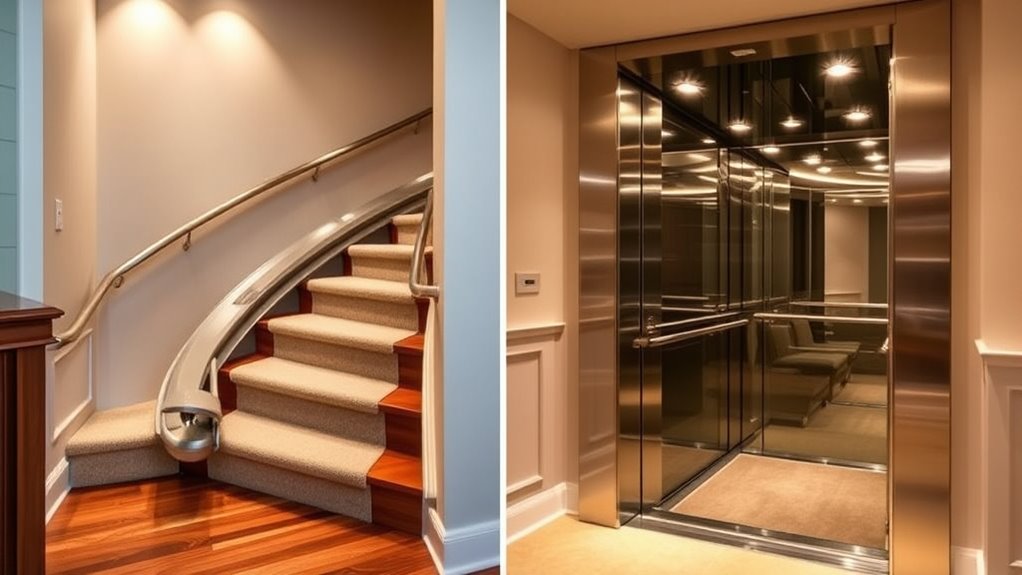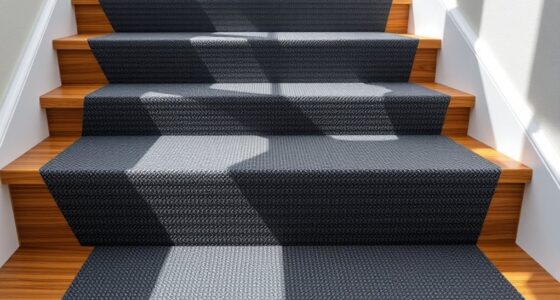When choosing between a stair lift and a home elevator, consider safety features, costs, and space. Stair lifts are more affordable, easier to install, and need less space, making them ideal for most staircases. Elevators offer full access, safety doors, and smoother rides but require more space and higher investment. Both can integrate with security systems to guarantee safety. To make the best choice for your home, explore detailed differences ahead.
Key Takeaways
- Stair lifts are more affordable, quicker to install, and require minimal structural modifications compared to home elevators.
- Elevators demand dedicated space, shaft construction, and complex electrical work, making installation more time-consuming and costly.
- Maintenance costs are generally lower and simpler for stair lifts than for elevators, which need regular professional servicing.
- Stair lifts are suitable for curved or straight staircases, while elevators require significant space and structural adjustments.
- Safety features are essential for both systems, but elevators often include additional safety components like emergency alarms and backup power.

When choosing a mobility solution for your home, deciding between installing a stair lift or a home elevator depends on your needs, space, and budget. Both options aim to improve accessibility, but they come with different considerations, especially around safety and costs. Safety considerations are paramount, so you’ll want to evaluate how each system ensures user security. Stair lifts are generally straightforward to operate and include safety features like seat belts, obstacle sensors, and secure locking mechanisms. They’re designed to prevent falls or accidental disengagement during use, which makes them a reliable choice for many users. On the other hand, home elevators have more complex safety features, such as emergency alarms, backup power, and smooth acceleration controls. They often include safety doors that prevent accidental falls into the shaft, but their operation requires more attention to safety standards during installation.
Installation costs are another vital factor. Stair lifts are typically less expensive to purchase and install, making them a cost-effective solution for many households. Their installation usually involves attaching a rail system along the staircase and fitting the chair, which can be completed in a day or two. Conversely, home elevators involve a much more extensive installation process. They require a dedicated shaft or space, structural modifications, and more sophisticated electrical work. Because of this, the upfront costs are markedly higher, and installation timelines are longer. If budget constraints are tight, a stair lift might be the more practical option, offering immediate benefits without extensive remodeling.
Additionally, consider the long-term expenses. Maintenance costs for stair lifts are generally lower and less complicated, often limited to periodic inspections and basic repairs. Elevators, however, demand ongoing maintenance to guarantee safety and proper operation, which can add to your overall expenses over time. You’ll also need to think about the space available—stair lifts are ideal for curved or straight staircases without requiring much room, while elevators need a dedicated shaft or significant space, which could impact your home’s layout. Furthermore, home security systems are increasingly integrated with smart technology, providing additional safety features that could benefit both stair lift and elevator users by ensuring safety protocols are followed.
Frequently Asked Questions
What Are the Long-Term Maintenance Costs for Stair Lifts Versus Home Elevators?
You’ll find that maintenance costs for stair lifts are generally lower, often requiring simple annual checks and occasional parts replacement, which keeps expenses predictable. Home elevators, on the other hand, tend to have higher maintenance costs due to their complexity, with more frequent inspections and potential repairs. Over their lifespan, stair lifts usually have a longer lifespan comparison, making them more cost-effective for ongoing maintenance.
How Do Installation Times Compare Between Stair Lifts and Home Elevators?
Installation times for stair lifts are quicker and simpler because of their lower installation complexity, often taking just a few hours. In contrast, home elevators require more extensive planning, permits, and longer installation periods, sometimes spanning several days. This means you’ll enjoy immediate user convenience with stair lifts, while elevators demand more time upfront but offer greater accessibility for multiple users or future needs.
Are There Any Weight or Size Restrictions for These Mobility Devices?
Think of your mobility device as a tailored suit—designed to fit perfectly. Both stair lifts and home elevators have weight limits and device dimensions you need to observe. For stair lifts, typical weight limits range from 250 to 350 pounds. Home elevators often accommodate up to 750 pounds or more. Always check specific model specifications to guarantee your device suits your size and weight, keeping safety and comfort in perfect harmony.
Can Stair Lifts and Home Elevators Be Customized for Specific Home Layouts?
Yes, stair lifts and home elevators can be tailored to fit your home layout. You can choose from various customization options, such as seat styles, color finishes, and control placements for stair lifts. For home elevators, options include cabin size, door configurations, and interior finishes. These adaptations ensure the devices seamlessly integrate into your space, providing comfort and safety tailored to your home’s unique layout.
What Safety Features Are Included in Each Option?
Safety isn’t just a feature; it’s the foundation. Both stair lifts and home elevators prioritize safety compliance, ensuring your peace of mind. Stair lifts often include seat belts, obstruction sensors, and swivel seats, while home elevators feature emergency stop buttons, backup power, and alarm systems. You get reliable emergency features in both options, but the choice depends on your specific mobility needs and home layout.
Conclusion
Choosing between a stair lift and a home elevator depends on your needs and budget. While a stair lift offers a cost-effective, quick solution, some worry it might feel limiting. However, modern designs are comfortable and reliable, making daily life easier without the hefty price tag. Remember, investing in accessibility isn’t just about convenience — it’s about maintaining your independence and safety in your own home. Whichever option you choose, it’s a step toward peace of mind.








